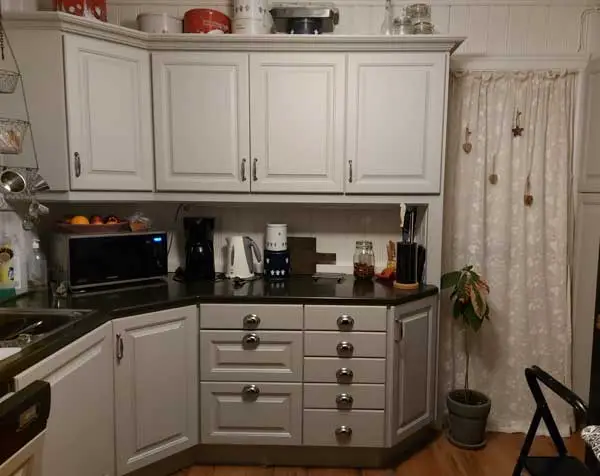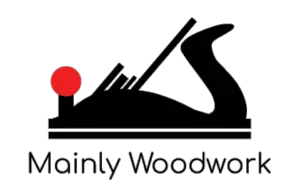Disclosure: This post may contain affiliate links, meaning I get a commission if you decide to make a purchase through my links, at no extra cost to you.
MDF might have a bad reputation for being a poor-quality wood product. Or just used to make furniture and cabinets cheaper. But MDF really does have a lot of good uses, and it even wins over solid wood in some cases.
MDF is short for medium-density fiberboard. MDF is an engineered wood product made up of fine wooden fibers and adhesives densely compressed together. MDF is used by woodworkers to create kitchen cabinets, furniture, or to be used as soundproofing.
MDF is a wooden product made by breaking the wood into wood fibers, adhesives, and wood fibers are then mixed together and pressed to create MDF plates. MDF is short for medium-density fiberboard.

In this article, I will discuss:
– What MDF is
– Pros And Cons of MDF
– What it is used for
– How it is made
– MDF, HDF, and LDF
What is MDF?
MDF is the ground beef of wooden materials.
The material of MDF is proper wood, broken down into a pulp, it is then mixed with resins that make the wood fibers stick together and gives the MDF its solid form.
MDF is in many cases used as a cheaper and often superior replacement for solid wood, kitchen cabinets are a great example of when MDF can be a good replacement. You can even get MDF that is water and heat resistant so it can be placed close to water sources like the sink, and baking ovens.
Since MDF is made from such fine fibers it gets a uniform texture and shape. This makes MDF predictable to work with, MDF is stable and we always know how MDF is going to react when we use it.
There are no knots in MDF, MDF does not leave chipped edges when being sawed and MDF will not warp or bend with changing moisture content in the air as wood does.
The kryptonite of MDF is getting moisture in its core. If moisture reaches the core of an MDF panel it will swell and will not revert back to its original form after drying, so the MDF plate is ruined if water penetrates to the core. Water can get into the MDF through untreated MDF Edges.
MDF: Pros and Cons
Pros of MDF
- Smooth Surface
- Stable
- No Knots
- Takes paint well
- Does not warp in changing air humidity
- Cheaper than solid wood
- Enviromental
- Perfect for indoor use
- Hard to distinguish from real wood when painted
- versatile for many different applications
Cons of MDF
- Does not take stain
- Does not have a grain structure
- Swells if water penetrated the protection
- Poor base for nail and screws
How MDF Is Made (Simplified)

To understand and better work with MDF we need to know what it is made of and how it is made. I will give a simplified version of how it is made, but in enough detail, for us to understand what MDF is made up of.
The first step of making MDF is to remove the bark from the wood. When the bark is removed the wood goes through a chipper that turns the wood into woodchips, the woodchips are cleaned and passed underneath a magnet that removes all metal and impurities in the wood. The wood now gets ground down into even finer pieces that we call wood fibers. The wood fibers are mixed with adhesives, when mixed we have the final mixture of the MDF. The mixture is laid down in thick square mattes and goes to a press that makes the MDF compound more dense and ready for use.
Wanna learn more about how MDF is made: Check out this detailed article I made about the process.
6 Uses of MDF wood
MDF can be used for most of the same indoor items as solid wood can. MDF can be used for things like furniture, kitchen cabinets, wall panels, shelves, and much more. In general, we can use MDF for the same applications that we can use wood for. But with some limitations, we do not want MDF to carry too much load and we should be careful with using outside because we risk getting water on it and it swelling.

Here are six good uses for MDF.
1. Wall Panels
MDF is perfect to use for wall panels since we usually want to keep our walls straight and don’t want them to warp. MDF wall panels are superior to solid wood in almost all aspects. MDF is cheaper, MDF does not change shape and warp, MDF can be produced to be more fire-resistant and MDF comes in premade wall panels that are as simple as lego to attach to one another.
2. Cabinet Fronts
Many people choose to make the cabinets in solid wood but choose to use MDF for the cabinet fronts. By using MDF for cabinet fronts, there will be no warping of the material compared to wood. So no cracks will appear in the joints, and the paint will not become uneven with time.
You can do the desired routing, cutting, and desired processing with the MDF cabinet fronts.

3. Furniture
Furniture made by MDF has become more and more popular in recent years. You are probably familiar with IKEA and that they do not always use “Real Wood” for their furniture. Ikea makes extensive use of MDF in their furniture, and that can be both a good and a bad thing. But one thing I for sure, the use of MDF in furniture makes the furniture cheaper for the consumer.
You can also make high-quality furniture with high-quality MDF.
4. Shelves
You can make all types of shelves with MDF. Bookshelves, spice shelves, corners shelves, floating shelves, and many more. But the one important thing about using MDF for shelve making is that you have to make sure the MDF is supported properly and does not have to bear a lot of leveraged weight.
Use proper supports and MDF will be a great option to use for shelves.
5. Counter tops
MDF can also be used for countertops in the kitchen and bathroom. Now I know that I told you that MDF is not good with water. But you can get MDF that is resistant to water. Compared to standard MDF, the moisture-resistant ones is a little bit more expensive.
6. Soundproofing
MDF is actually great for soundproofing elements in the home. MDF has good soundproofing characteristics because of its density. MDF is cheap and can be obtained in different thicknesses depending on the range of soundproofing you want.
LDF VS MDF VS HDF
| LDF | MDF | HDF | |
| Density | 600 – 700kg/m³ | 600 – 800kg/m³ | 800-900kg/m³ |
MDF stands for medium-density fibreboard. The name medium-density fibreboard implicates the existence of high-density fibreboards and low-density fibreboards. And that is exactly right. Since you probably know what MDF is now, let me explain quickly what low-density fibreboard (LDF) and high-density fibreboard (HDF) are.
LDF ( Low Density Fibreboard)
LDF is also commonly called particleboard. MDF wood is usually less dense than MDF. The wood chips used for LDF are not broken down into such fine fibers as MDF is. LDF does not react as well as MDF to being worked with because of the size of the woodchips used, the wood has more of a tendency to tear out. But LDF can still be used for lower quality furniture, soundproofing, cabinets, flooring, roofing, and insulation.
HDF (High-Density Fibreboard)
HDF has a higher density than MDF. MDF and HDF are actually very different types of materials. HDF usually comes in thicknesses of 3 to 8mm and is most commonly used as the core material of laminate flooring. HDF is also used
